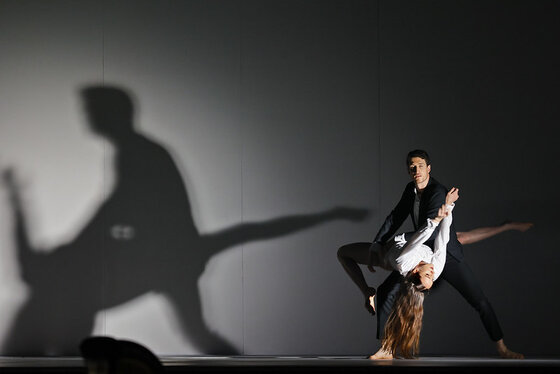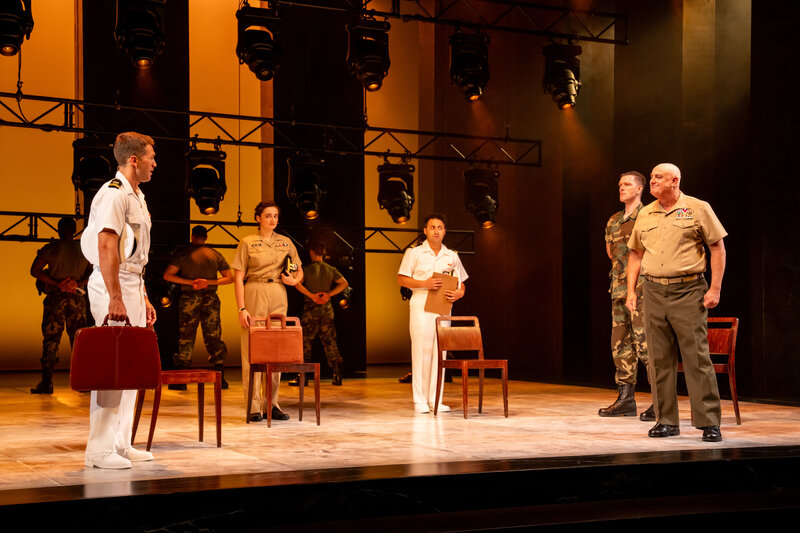Greed and lust are at the heart of Nobel Prize winning playwright Eugene O’Neill’s primordial tragedy, Desire Under the Elms; which takes plot elements and themes from Greek tragedy and adapts them to a rural New England setting in 1850.
 In his mid 70s, Ephraim Cabot (Darren Mort) returns to his remote farm with his third wife, alluring and headstrong Abbie Putnam (Diana Brumen), aged 35. Tending to the cattle is Cabot’s son from his second marriage, Eben (Samuel Lavery), who has two older half brothers, Simeon (Timothy Smith), 39 and Peter (Garikai Jani), 37. The pair is headed west to seek their fortunes on the goldfields of California, but not before staying around just long enough to lambast their father, for whom they have utter contempt. There is no love lost either between Eben and his dad, who regards his youngest as weak and inconsequential, a “blaspheming fool”. Eben has never really gotten over the death of his mother, whom Cabot treated poorly. He believes her ghost still watches over the farm. Eben begins a passionate and dangerous affair with his father’s new wife.
In his mid 70s, Ephraim Cabot (Darren Mort) returns to his remote farm with his third wife, alluring and headstrong Abbie Putnam (Diana Brumen), aged 35. Tending to the cattle is Cabot’s son from his second marriage, Eben (Samuel Lavery), who has two older half brothers, Simeon (Timothy Smith), 39 and Peter (Garikai Jani), 37. The pair is headed west to seek their fortunes on the goldfields of California, but not before staying around just long enough to lambast their father, for whom they have utter contempt. There is no love lost either between Eben and his dad, who regards his youngest as weak and inconsequential, a “blaspheming fool”. Eben has never really gotten over the death of his mother, whom Cabot treated poorly. He believes her ghost still watches over the farm. Eben begins a passionate and dangerous affair with his father’s new wife.
Mind you, it doesn’t start out like that because Eben resents Abbie for scheming to take what he feels is his rightful inheritance, the farm … and he initially expresses his hatred for her. Over time though, he comes to love Abbie and she him, but their union is bound to end badly – very badly.
O’Neill, who wrote Desire Under the Elms in 1924, described it as “a tragedy of the possessive – the pitiful longing of man to build his own heaven here on earth by glutting his sense of power”. It took me 10 minutes or so to get used to the strong accents, but there was no doubting the energy that was apparent on stage from the get go. This is a dysfunctional family if I ever saw one. Bickering and brawling – even spitting – predominate (especially the former) as vitriol and bravado abound.
All are suspicious of one another and their motives, save, perhaps, for the two older brothers who are like peas in a pod. Rather than leaving his farm to anyone, the old man is inclined to burn it to the ground. So much for solid family values. None are likeable characters, but the power in the performances is not to be questioned.
The actors, appropriately kitted out in period attire by costume designer Cindy Hanara, appear to relish the frequent explosions of bile that are such an intergral part of the script. At times Desire Under the Elms crosses the line between drama and melodrama and, unfortunately, that detracts from its overall impact.
 High points in the action and dialogue need to be given more time to breathe, especially a pivotal scene towards the end, from which there is no coming back for any of the characters still in play. Instead, the said scene is subjugated and downplayed. I dare suggest it is a relatively straightforward fix for producer and director Andrei Schiller-Chan.
High points in the action and dialogue need to be given more time to breathe, especially a pivotal scene towards the end, from which there is no coming back for any of the characters still in play. Instead, the said scene is subjugated and downplayed. I dare suggest it is a relatively straightforward fix for producer and director Andrei Schiller-Chan.
A standout for me was the set design by Hahna Read – a vintage wooden table and four chairs, behind which is an old style kitchen, being the centerpiece, backing onto a stone wall. Then, alongside, is a two storey structure with a nine step ladder leading to a bedroom on the upper level and a parlour with couch and rocking chair below, where Abbie and Eban first “do the deed”. Behind is a withering elm tree, which sums up the plight of the protagonists. Desire Under the Elms is playing at Chapel off Chapel until 24th July.
Alex First

David Edwards is the former editor of The Blurb and a contributor on film and television




